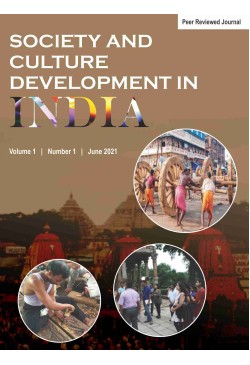
Society and Culture Development in India
Frequency :Bi-Annual
ISSN :2583-0694
Peer Reviewed Journal
Contents and Editorial Note
The Role of Weekly Market among the Paudibhuyans of Keonjhar District Odisha
Bhowmick, A. (2022). The Role of Weekly Market among the Paudibhuyans of Keonjhar District Odisha, Society and Culture Development in India, 2: 2, pp. 239-246. https://doi.org/10.47509/SCDI.2022.v02i02.01
Contextual Determinants of Fertility Transitions among Black South African Women: A Multi-Level Analysis
Leonard, A., & Sabiti, I.K. (2022). Contextual Determinants of Fertility Transitions among Black South African Women: A Multi-Level Analysis, Society and Culture Development in India, 2: 2, pp. 247-271. https://doi.org/10.47509/SCDI.2022.v02i02.02
Impact of Mass Media on Rural Women: A Study of Shimla District
Kumar, A., & Lahaik, P. (2022). Impact of Mass Media on Rural Women: A Study of Shimla District, Society and Culture Development in India, 2: 2, pp. 273-289. https://doi.org/10.47509/SCDI.2022.v02i02.03
Social Media Response in Disaster Management with Special Reference to the Kerala Floods
Joseph, J.E. (2022). Social Media Response in Disaster Management with Special Reference to the Kerala Floods, Society and Culture Development in India, 2: 2, pp. 291-303. https://doi.org/10.47509/SCDI.2022.v02i02.04
Understanding The Impact of Web 2.0 and Social Media on English Language Learning and Teaching: A Systematic Literature Review
Uddin, M., Saif, S., & Montaha, S. (2022). Understanding the Impact of Web 2.0 and Social Media on English Language Learning and Teaching: A Systematic Literature Review, Society and Culture Development in India, 2: 2, pp. 305-317. https://doi.org/10.47509/SCDI.2022.v02i02.05
Urban Welfare Reforms in Asia: A Sociological Appraisal
Sheykhi, M.T. (2022). Urban Welfare Reforms in Asia: A Sociological Appraisal, Society and Culture Development in India, 2: 2, pp. 319-328. https://doi.org/10.47509/SCDI.2022.v02i02.06
Understanding Caste in Uttar Pradesh Politics
Yadav, N. (2022). Understanding Caste in Uttar Pradesh Politics, Society and Culture Development in India, 2: 2, pp. 329-338. https://doi.org/10.47509/SCDI.2022.v02i02.07
Practicing Child Birth Rituals: Reproducing Motherhood and Patriarchy
This paper seeks to investigate the birth rituals described in Hindu scriptures and the indigenous birth rituals performed by the Bengali community in order to comprehend the implicit value system they embody. The rituals’ ingrained value system is viewed primarily in two categories- first, the conditioning of women for motherhood through birth rituals and, second, the extent to which these rituals sustain patriarchy. This socialisation through birth rites contributes to a woman’s social and self-identification as a mother. To analyse these processes, attempts are undertaken to examine birth rites in the social life of Bengali folk culture and in Hindu scripture sources. This study will concentrate solely on Hindu birth rites found in scriptural texts and folk birth rituals performed by Hindus. A field study was also conducted in order to provide a comprehensive understanding of traditional ceremonies.
???????Keywords: Birth Rituals, Socialisation, Social Change, Motherhood, Patriarchy
Sharma, R. (2022). Practicing Child Birth Rituals: Reproducing Mortherhood and Patriarchy, Society and Culture Development in India, 2: 2, pp. 339-353. https://doi.org/10.47509/SCDI.2022.v02i02.08
Durga Puja in Kolkata: A Cultural Diaspora of Celebration
Sharma, R. (2022). Practicing Child Birth Rituals: Reproducing Mortherhood and Patriarchy, Society and Culture Development in India, 2: 2, pp. 355-373. https://doi.org/10.47509/SCDI.2022.v02i02.09
Levels of Social Exclusion and Variations in Exclusion and Inclusion Practices Among Castes and Tribes of Andhra Pradesh: An Empirical Research Study
In rural India levels of social exclusion and inclusion vary from one social group to another social group and also from one ethnic group to another based on the ecological, geographical, social, cultural and economic factors. An individual or groups of individuals in any excluded social group or ethnic group invariably encounter the problem of exclusion in daily life. Moreover it is contextual and situational intertwined with the geographically culturally inbuilt mechanism. The forms of exclusion also differ from one ethnic group to another living in different social environments, geographical and economic conditions. This empirical research work paper presents the levels of social exclusion, mechanism, forms and variations in between the stratified caste society and egalitarian tribal society. The level of social exclusion at each excluded social group definitely correlates and corresponds with the development status of it in the caste based society of India, in specific to Rural India, Rural Andhra Pradesh. The empirical field work based observations in three multi caste villages of Manduru, Morampudi and Vedullapalle as well as in three multi tribal villages of Pasuvulabanda, Kolapari and Lammasingi, located in the newly carved Andhra Pradesh state have been presented in this research article. It is descriptive in nature and comprises Anthropological qualitative explanations with both etic and emic perspectives.
???????Keywords: Social Exclusion, Inclusion, Castes, Tribes, Cultural Variation
Subramanyam, V. (2022). Levels of Social Exclusion and Variations in Exclusion and Inclusion Practices among Castes and Tribes of Andhra Pradesh: An Empirical Research Study, Society and Culture Development in India, 2: 2, pp. 375-385. https://doi.org/10.47509/SCDI.2022.v02i02.10
Factors Affecting Selection of Marketing Channel for Vegetable Farmers in Sundargarh, Distirct
Keywords: Gaddiwala, Tribal Farmers, Kuchni, Eigen Value
Kerketta, S., & Mahalik, D.K. (2022). Factors Affecting Selection of Marketing Channel for Vegetable Farmers in Sundargarh, District, Society and Culture Development in India, 2: 2, pp. 387-397. https://doi.org/10.47509/SCDI.2022.v02i02.11